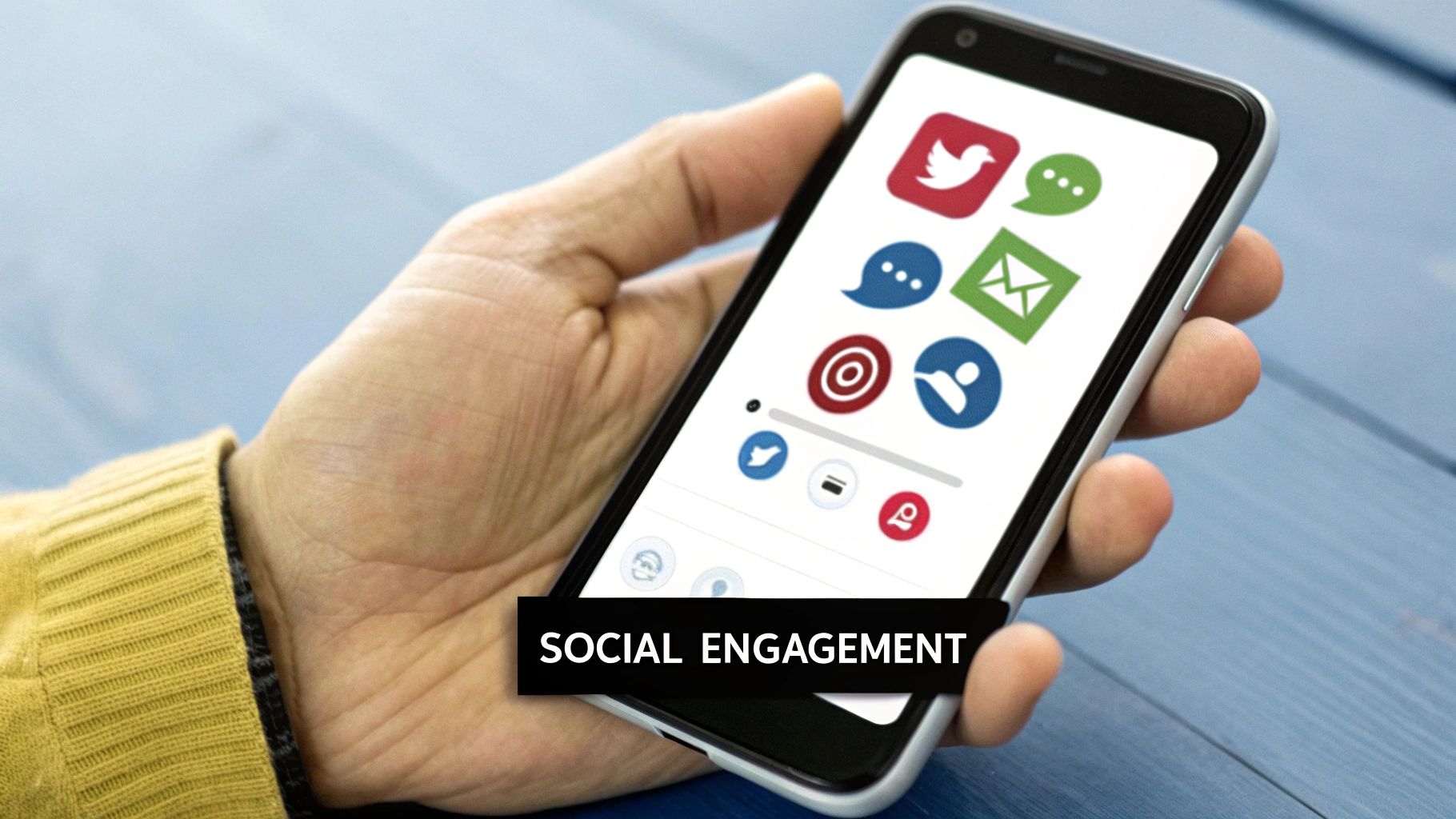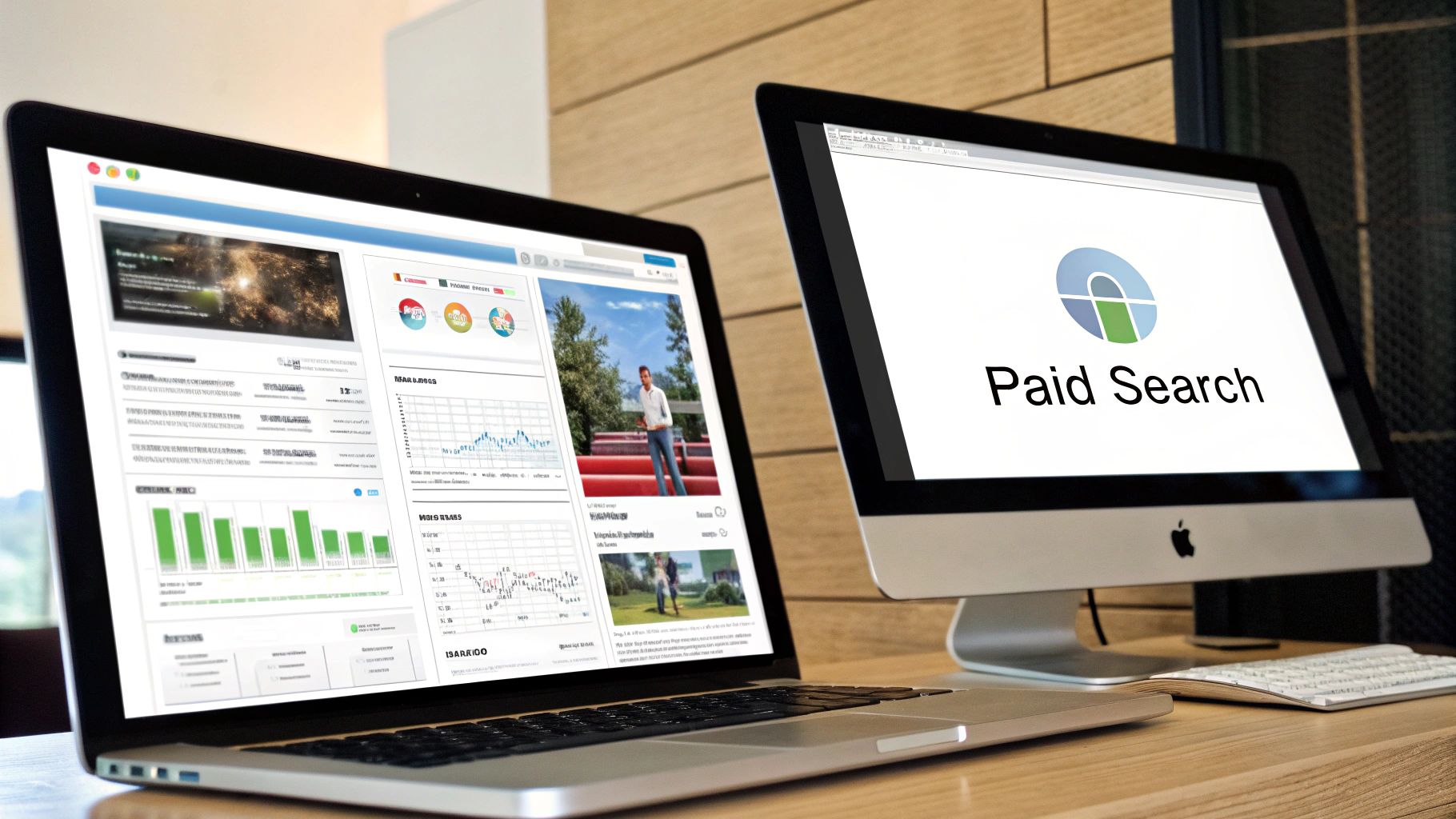9 Best Ways to Generate Leads for UK SMEs in 2025

Best Ways to Generate Leads for UK SMEs: In today’s competitive marketplace, standing still means falling behind. For UK-based SMEs and ecommerce brands, the ability to consistently attract and convert new customers is the lifeblood of sustainable growth. But with countless strategies vying for your attention and budget, identifying the most effective channels can feel overwhelming. This is particularly true for busy brand owners and marketing managers trying to scale their operations without wasting resources on tactics that don’t deliver.
This comprehensive guide cuts through the noise. We will explore the nine best ways to generate leads, moving beyond surface-level advice to provide actionable, in-depth strategies tailored specifically for the UK market. Forget generic tips; we are focusing on practical implementation. You’ll get a clear view of the pros, cons, and real-world applications of each powerful method, from the immediate impact of Pay-Per-Click (PPC) advertising to the long-term authority built through high-value content marketing. Understanding the core principles is the first step, and from there you can explore more detailed strategies to generate more leads to refine your approach.
Our goal is to give you a strategic blueprint. By the end of this article, you will have the insights needed to build a powerful, multi-channel lead generation engine. This will help you drive measurable results and a significant return on investment for your business in 2025 and beyond. Let’s dive into the methods that will unlock your next stage of growth.
1. Content Marketing & SEO (Best Ways to Generate Leads for UK SMEs)
Content marketing and Search Engine Optimisation (SEO) work together as one of the most powerful and sustainable methods to generate high-quality leads. This strategy centres on creating and distributing valuable, relevant, and consistent content to attract and retain a clearly defined audience. The goal is to solve your audience’s problems, answer their questions, and build trust, ultimately driving them towards a purchasing decision. By optimising this content for search engines, you ensure it appears prominently when potential customers are actively looking for solutions you provide, making it one of the best ways to generate leads organically.
This inbound approach, popularised by pioneers like HubSpot, focuses on drawing customers in rather than pushing your message out. For a UK SME, this could mean creating a detailed blog post about “choosing the right accounting software for UK startups” or an e-commerce brand developing a guide on “how to style a trench coat for the British weather.” These assets attract targeted traffic and establish your brand as a credible authority.
How to Implement Content & SEO for Lead Generation
- Focus on ‘Pillar’ and ‘Cluster’ Content: Create comprehensive “pillar” pages on broad topics essential to your business (e.g., “A Guide to Digital Marketing for SMEs”). Support these with shorter “cluster” articles that delve into specific sub-topics (e.g., “social media advertising costs” or “email marketing best practices”) and link back to the pillar page. This structure signals expertise to Google and helps users find related information.
- Develop High-Value Lead Magnets: Offer irresistible, free resources in exchange for contact information. This could be a downloadable checklist, a detailed industry report, an exclusive case study, or a practical template. The key is providing genuine value that solves a specific pain point for your ideal customer.
- Optimise for Commercial Intent Keywords: Go beyond broad keywords. Use SEO tools to find long-tail keywords (phrases of three or more words) that indicate a user is close to making a purchase. For example, instead of targeting “men’s shoes,” focus on “best waterproof leather boots UK.”
By consistently creating problem-solving content and optimising it for search, you build a valuable, long-term asset that generates qualified leads for your business around the clock.
2. Social Media Marketing
Best Ways to Generate Leads for UK SMEs: Social media marketing has evolved far beyond simple brand awareness; it’s a dynamic and powerful channel for direct lead generation. This strategy involves building relationships, sharing valuable content, and engaging with potential customers on platforms where they spend their time. By establishing a strong, authentic presence, you can nurture a community that trusts your brand, making them more receptive to your offers and ultimately guiding them into your sales funnel. For a UK-based business, this is one of the best ways to generate leads by connecting directly with a targeted audience in a personalised, conversational manner.

Social Engagement – An Effective Way to Generate Leads for UK SMEs
Popularised by evangelists like Gary Vaynerchuk, this approach champions authenticity and value exchange over hard selling. Success isn’t just about follower count; it’s about engagement and relationship building. For instance, LinkedIn itself is a testament to this, generating an estimated 80% of B2B social media leads. A UK tech startup could use LinkedIn to share industry insights and connect with key decision-makers, while a fashion e-commerce brand could use Instagram Stories polls and user-generated content campaigns to build a loyal following that converts.
How to Implement Social Media Marketing for Lead Generation
- Choose Platforms Strategically: Don’t spread yourself thin. Focus your efforts where your ideal customers are most active. For B2B SMEs, LinkedIn and X (formerly Twitter) are often prime territories. For e-commerce brands targeting younger demographics, Instagram, TikTok, and Pinterest are typically more effective.
- Engage Proactively and Authentically: Go beyond just posting. Use social listening tools to find conversations about your industry or pain points you solve. Join relevant groups, answer questions, and offer advice without an immediate sales pitch. Building this rapport establishes credibility and keeps your brand top-of-mind.
- Utilise Platform-Specific Lead Tools: Leverage built-in features designed for lead capture. For B2B, LinkedIn Sales Navigator is an unparalleled tool for identifying and connecting with prospects. For B2C and B2B, you can discover more about Facebook lead generation ads, which allow users to submit their information via a pre-filled form without ever leaving the platform, dramatically reducing friction.
By combining consistent, valuable content with strategic engagement and targeted advertising, social media becomes a direct and scalable pipeline for acquiring high-quality leads.
3. Email Marketing (Best Ways to Generate Leads for UK SMEs)
Email marketing remains one of the most direct and effective channels for nurturing prospects and converting them into loyal customers. This strategy involves building a list of subscribers and sending them targeted communications, from automated welcome sequences and newsletters to promotional offers. Unlike social media, where algorithms control reach, email provides a direct line to your audience, allowing you to build relationships, provide value, and guide them through the sales funnel at your own pace. This makes it one of the best ways to generate leads with a high return on investment.
This powerful inbound and outbound hybrid, championed by platforms like Mailchimp and ConvertKit, gives businesses complete ownership of their audience. For a UK-based B2B service provider, this might involve an automated sequence that educates new leads about industry challenges before introducing a solution. Similarly, a British fashion e-commerce brand could use weekly style guides and exclusive discounts to turn one-time buyers into repeat customers. The key is delivering personalised, relevant content directly to an engaged inbox.
How to Implement Email Marketing for Lead Generation
- Create Compelling Lead Magnets: The foundation of a strong email list is a valuable incentive. Offer high-quality, free resources like a definitive guide, a practical checklist, an exclusive webinar, or a discount code in exchange for an email address. This ensures you attract subscribers who are genuinely interested in what you offer.
- Segment Your List and Automate Nurturing: Avoid sending generic blasts. Segment your audience based on their interests, past purchases, or how they signed up. Use marketing automation to create tailored “drip” campaigns that nurture leads over time, providing relevant information at each stage of their journey to build trust and readiness to buy.
- Maintain a Consistent and Valuable Schedule: Whether it’s daily, weekly, or bi-weekly, a consistent sending schedule builds anticipation and keeps your brand top-of-mind. Focus every email on providing value, whether through education, entertainment, or exclusive offers. Test different subject lines, send times, and content formats to optimise engagement and conversions.
4. Pay-Per-Click (PPC) Advertising
Best Ways to Generate Leads for UK SMEs: Pay-Per-Click (PPC) advertising is a powerful digital marketing model where businesses pay a fee each time one of their ads is clicked. Platforms like Google Ads and Bing Ads allow you to bid for ad placement in a search engine’s sponsored links when someone searches for a keyword related to your business offering. This method is one of the best ways to generate leads because it allows you to capture high-intent traffic at the precise moment a potential customer is looking for your products or services, delivering immediate and measurable results.

Paid Search – Proven Lead Generation Strategy for UK SMEs
Unlike organic strategies, which take time to build momentum, PPC can drive traffic and leads almost instantly. For a UK-based SME, this could mean running a targeted campaign for “emergency plumber in Manchester” or an e-commerce brand promoting “vegan leather handbags UK sale.” Companies like WordStream famously generate a significant portion of their own leads through Google Ads, showcasing the model’s effectiveness when managed correctly. The key is driving this paid traffic to highly optimised, dedicated landing pages designed specifically for conversion.
How to Implement PPC for Lead Generation: Best Ways to Generate Leads for UK SMEs
- Start with High-Intent Commercial Keywords: Begin your campaigns by focusing on long-tail keywords that signal a user is ready to buy or enquire. Phrases like “get a quote for business insurance” or “buy organic dog food online” attract users who are further down the sales funnel, leading to higher conversion rates and a better initial return on investment.
- Create Dedicated Landing Pages: Never send PPC traffic to your homepage. For each ad group, create a specific landing page with a single, clear call-to-action (CTA). The messaging on the page must directly match the ad copy that the user clicked, ensuring a seamless and relevant user experience that encourages lead submission.
- Use Negative Keywords to Improve Targeting: Actively build a list of negative keywords to prevent your ads from showing for irrelevant searches. For a company selling premium software, negative keywords might include “free,” “cheap,” or “tutorial.” This simple step significantly improves targeting, reduces wasted ad spend, and increases the quality of your leads. You can learn more about how Google’s automated systems can help with this by reading about Google Ads smart bidding strategies.
- Implement Conversion Tracking from Day One: To measure your true return on investment (ROI), you must have conversion tracking set up correctly. This allows you to see exactly which keywords, ads, and campaigns are driving leads, enabling you to optimise your budget and scale what works.
5. Webinars and Virtual Events
Hosting webinars and virtual events is a highly effective strategy for generating a large volume of engaged leads in a short period. This method involves creating and delivering live or pre-recorded online presentations that offer deep, practical value to a specific audience. By tackling a significant pain point or teaching a valuable skill, you attract potential customers who are actively seeking solutions. The registration process itself is a powerful lead capture mechanism, providing you with a list of interested prospects who have given you permission to contact them.
Popularised by marketing experts like Amy Porterfield and Russell Brunson, this approach positions your brand as a leading authority in its field. For a UK-based software company, this might be a live demo on “Streamlining HR Processes for Remote UK Teams,” while an e-commerce brand could host a virtual workshop on “Mastering Seasonal SEO for Your Online Store.” The interactive nature of these events builds a direct connection with your audience, making it one of the best ways to generate leads that are already warmed up to your brand and message.
How to Implement Webinars for Lead Generation
- Choose a High-Impact, Problem-Solving Topic: Your webinar’s success hinges on its topic. Don’t create a thinly veiled sales pitch. Instead, focus on a pressing challenge your ideal customer faces. Use tools like AnswerThePublic or browse industry forums to identify common questions and pain points that you can solve.
- Promote Extensively Across Multiple Channels: Treat your webinar launch like a product launch. Promote it via email marketing to your existing list, run targeted social media ads, share it in relevant LinkedIn groups, and partner with complementary businesses to cross-promote. The more targeted your promotion, the higher the quality of your registrants.
- Engage and Follow Up Strategically: Use interactive elements like live polls, Q&A sessions, and chat to keep attendees engaged. Afterwards, segment your follow-up. Send a recording and a special offer to attendees, and a separate “sorry we missed you” email with the recording to no-shows to re-engage them. This ensures you maximise lead potential from everyone who registered.
By delivering genuine value through educational events, you not only capture contact details but also build significant trust and authority, accelerating the journey from prospect to loyal customer.
6. Referral Programs
Best Ways to Generate Leads for UK SMEs: Referral programs systematise word-of-mouth marketing, turning your happiest customers into a proactive sales force. This strategy incentivises existing clients, partners, or contacts to recommend your business, generating leads that often come with a pre-existing layer of trust. When a trusted friend or colleague recommends a service, the endorsement carries significant weight, leading to higher conversion rates and better customer loyalty. This makes a well-structured referral system one of the best ways to generate leads that are both high-quality and cost-effective.
This approach leverages the principle of social proof, popularised by companies like Dropbox, whose famous referral program offered extra storage space to both the referrer and the new user, driving a 3900% growth in 15 months. For a UK-based SaaS company, this could mean offering a one-month subscription discount for a successful referral, while a local tradesperson might offer a gift card to a popular high-street retailer. The key is that the reward is valuable enough to motivate action.
How to Implement a Referral Program for Lead Generation
- Make it Effortless: The referral process must be incredibly simple. Provide customers with a unique, shareable link or code they can distribute with a single click. The easier it is for them to share, the more likely they are to do it. Platforms like ReferralCandy can help automate and manage this process.
- Offer a Two-Sided Incentive: The most successful programs reward both the person making the referral and the new customer they bring in. This “give-get” model creates a win-win scenario. For example, an e-commerce brand could offer the referrer £10 off their next purchase and give the new customer 15% off their first order.
- Promote It Everywhere: Your referral program should not be a secret. Promote it on your website homepage, in email signatures, on post-purchase confirmation pages, and through dedicated social media campaigns. Integrate it into every relevant customer touchpoint to ensure maximum visibility and participation.
By systematically encouraging and rewarding advocacy, you create a powerful, self-perpetuating engine that consistently delivers warm, high-intent leads directly to your business.
7. Sales Outreach and Cold Calling: Best Ways to Generate Leads for UK SMEs
Sales outreach and cold calling represent a direct, proactive method for lead generation, moving beyond waiting for customers to find you. This strategy involves identifying and contacting potential customers who have not previously expressed interest in your product or service. Through channels like phone calls, personalised emails, and LinkedIn messages, the goal is to initiate a conversation, understand the prospect’s needs, and qualify them as a potential lead. While often seen as traditional, a modern, well-executed outreach strategy remains one of the best ways to generate leads, particularly in B2B sectors.
This outbound approach, championed by figures like Aaron Ross in his ‘Predictable Revenue’ methodology, is about systematic, targeted engagement, not aggressive, untargeted selling. For a UK tech startup, this could mean contacting heads of IT at mid-sized logistics firms to discuss specific operational inefficiencies. The focus is on building a personal connection and demonstrating value from the very first interaction, turning a cold contact into a warm, qualified lead.
How to Implement Sales Outreach for Lead Generation
- Research and Personalise Meticulously: Generic outreach is ineffective. Before contacting anyone, research the individual and their company. Mention a recent company achievement, a shared connection, or a relevant article they’ve published. This level of personalisation shows you’ve done your homework and dramatically increases response rates.
- Adopt a Multi-Touchpoint Cadence: Don’t rely on a single email or call. Create a sequence of touchpoints across multiple channels (e.g., LinkedIn connection request, email, follow-up email, phone call) over several weeks. This persistence, when done respectfully, keeps your brand top-of-mind without being intrusive.
- Focus on Helping, Not Selling: Frame your initial outreach around solving a problem or offering value, not pitching your product. Lead with a helpful insight, a relevant statistic, or a question about their challenges. The initial goal is to start a conversation and build rapport, not to close a sale on the first call.
By combining thorough research with a value-driven, multi-channel approach, sales outreach can become a highly predictable and scalable engine for generating high-quality B2B leads.
8. Landing Page Optimisation
Best Ways to Generate Leads for UK SMEs: All traffic generation efforts, from PPC to social media, are ultimately wasted if the destination page fails to convert visitors. Landing Page Optimisation (LPO) is the critical process of improving every element on a dedicated webpage to maximise its ability to capture leads. Unlike a standard homepage with multiple navigation options, a landing page has one single, focused goal: to persuade a visitor to take a specific action, such as filling out a form, downloading a guide, or signing up for a trial. This laser focus makes it one of the most effective ways to generate leads from your existing traffic.
This strategy, championed by experts like Oli Gardner and platforms such as Unbounce and Leadpages, is about creating a frictionless path from click to conversion. For a UK-based software company, this means sending traffic from a “best accounting software” Google Ad to a page exclusively showcasing their product’s benefits for UK SMEs, not their generic homepage. For an e-commerce brand, it’s directing users from an Instagram ad for a specific dress to a page where they can buy that dress, not browse the entire catalogue.
How to Implement Landing Page Optimisation for Lead Generation
- Match the Message to the Medium: Ensure your landing page headline and copy directly reflect the ad or link the visitor clicked. If your ad promises a “50% Discount on SEO Audits,” the landing page must immediately reinforce that specific offer. This creates a seamless, trustworthy user experience and reduces bounce rates.
- Minimise Friction and Distractions: Remove all unnecessary navigation links, sidebars, and competing calls-to-action. The user should have only one clear path forward. Keep forms as short as possible, only asking for essential information. Each additional field you ask for can decrease your conversion rate.
- Leverage Social Proof and Urgency: Build credibility by including customer testimonials, case study snippets, trust badges (e.g., industry awards, security logos), and client logos. Create a sense of urgency with time-sensitive offers or by showing limited availability to encourage immediate action. Learn more by mastering landing page optimisation with proven techniques.
By systematically testing and refining your landing pages, you can significantly increase the ROI of every marketing campaign and turn more of your hard-earned traffic into valuable, qualified leads.
9. Partnership and Affiliate Marketing (Best Ways to Generate Leads for UK SMEs)
Partnership and affiliate marketing is a collaborative strategy where businesses team up with other companies, influencers, or individuals (affiliates) to cross-promote products and services. This approach leverages the established trust and audience of your partners, allowing you to tap into new, relevant customer pools. By creating mutually beneficial relationships, you can generate warm, high-intent leads that might otherwise be out of reach, making it one of the best ways to generate leads through strategic alliances.
This method works because it’s built on a foundation of trust and shared value. A recommendation from a respected partner acts as a powerful endorsement. For a UK-based eco-friendly cleaning brand, this could mean partnering with a popular sustainability blogger. The blogger earns a commission for every sale driven through their unique link, and the brand gains access to a pre-vetted, engaged audience. This model was pioneered by giants like Amazon Associates and has been perfected by B2B companies like HubSpot, whose partner program generates a significant portion of their leads.
How to Implement Partnership & Affiliate Marketing for Lead Generation
- Choose Complementary, Non-Competing Partners: Identify businesses or influencers whose audience mirrors your ideal customer profile but who aren’t direct competitors. A UK fintech app for freelancers could partner with accounting software firms or co-working spaces. The key is finding a symbiotic relationship where both parties offer value to the same audience.
- Create Clear Agreements and Provide Support: Establish a formal agreement outlining commission structures, payment terms, and promotional guidelines. To ensure success, equip your partners with a toolkit of marketing assets, such as branded banners, pre-written email copy, product images, and unique tracking links. The easier you make it for them to promote you, the more leads you will generate.
- Track and Measure Performance Relentlessly: Use partnership management software like PartnerStack or affiliate tracking tools to monitor key metrics. Pay close attention to clicks, conversion rates, and the quality of leads generated by each partner. This data allows you to identify your top performers and optimise your program for maximum ROI. By collaborating strategically, you can significantly enhance your growth. Learn more about the power of partnership to supercharge your strategy.
By building a robust network of partners and affiliates, you create a scalable, performance-based engine that drives consistent, high-quality lead generation for your business.
Top 9 Best Ways to Generate Leads for UK SMEs Comparison
| Marketing Strategy | Implementation Complexity 🔄 | Resource Requirements ⚡ | Expected Outcomes 📊 | Ideal Use Cases 💡 | Key Advantages ⭐ |
|---|---|---|---|---|---|
| Content Marketing & SEO | Medium – requires ongoing content and SEO expertise | Moderate – skilled content creators and SEO tools | Long-term organic traffic growth, quality leads | Brands aiming for sustained growth and thought leadership | Builds trust, cost-effective, lasting value |
| Social Media Marketing | High – daily management and platform-specific strategies | Moderate – content, ads, monitoring tools | Engagement, brand awareness, lead generation | Businesses targeting active social audiences | Direct access to users, advanced targeting |
| Email Marketing | Medium – requires list management and automation setup | Low to moderate – email platforms and content creation | High ROI, direct communication with prospects | Nurturing leads and retaining customers | High ROI, measurable, personalized outreach |
| Pay-Per-Click (PPC) Advertising | High – needs continuous optimization and bid management | High – budget for ads and management | Immediate traffic and lead generation | Fast lead generation targeting competitive keywords | Immediate visibility, budget control, targeted ads |
| Webinars and Virtual Events | High – extensive prep, tech setup, and presentation skills | Moderate – platform costs, content, and promotion | High-quality engaged leads, expert positioning | Educating and engaging audiences with interactive content | Real-time interaction, high conversions |
| Referral Programs | Medium – program setup and ongoing management | Low to moderate – incentives and tracking systems | High-quality, pre-qualified leads with viral potential | Businesses with satisfied customers seeking organic growth | Low acquisition cost, builds trust, scalable |
| Sales Outreach and Cold Calling | High – time-intensive, requires skilled salespeople | Moderate – CRM and research resources | Direct qualification, relationship building | High-value B2B sales requiring personal interaction | Immediate feedback, personal approach |
| Landing Page Optimization | Medium – requires design, testing, and technical skills | Moderate – design tools and testing platforms | Increased conversion rates | Campaigns needing optimized conversion funnels | Measurable ROI, higher conversions |
| Partnership and Affiliate Marketing | Medium – partner management and collaboration | Low to moderate – partner incentives and coordination | Access to new audiences, lead generation | Expanding reach via complementary businesses | Shared costs, credibility, scalable |
Building Your Integrated Lead Generation Strategy
Best Ways to Generate Leads for UK SMEs: We have journeyed through an extensive list of the best ways to generate leads, from the foundational power of Content Marketing and SEO to the direct impact of PPC Advertising and the community-building potential of Referral Programs. Each method, whether it’s the engaging format of a webinar or the targeted precision of a well-crafted email sequence, holds significant power on its own. However, the most profound and sustainable growth doesn’t come from mastering these tactics in isolation. The real key to unlocking exponential growth for your UK SME or ecommerce brand lies in integration.
True lead generation mastery is about building a cohesive, multi-channel engine where each part amplifies the others. Think of it not as a checklist to be completed, but as a set of interconnected gears. Your brilliant content marketing efforts, for instance, don’t just exist to rank on Google; they provide the fuel for your social media channels and the valuable assets you promote in your email newsletters. A successful webinar isn’t a one-off event; it’s a source of high-quality leads for your sales team and a piece of evergreen content you can repurpose for months to come.
From Tactics to a Unified System
The transition from executing individual tactics to orchestrating a unified strategy is what separates good marketers from great ones. This is where the magic happens. A potential customer might first discover your brand through a targeted Google Ad, click through to a highly optimised landing page, and download a free guide. This action places them into an automated email nurture sequence. A week later, they see a retargeting ad on LinkedIn promoting a case study related to their industry, which reinforces your authority. Finally, they receive a personal invitation to a webinar that addresses their specific pain points.
In this scenario, PPC, content marketing, landing page optimisation, and email marketing are not separate activities. They are a synchronised sequence of touchpoints that guide a prospect seamlessly from awareness to consideration, building trust and demonstrating value at every step. This integrated approach creates a powerful flywheel effect, transforming your marketing from a series of disjointed efforts into a predictable and scalable growth machine.
Your Actionable Next Steps on the Best Ways to Generate Leads for UK SMEs
Feeling overwhelmed by the possibilities is natural. The goal isn’t to implement all nine strategies by next Tuesday. The goal is to start smart and build momentum. Here is a practical path forward:
- Audit and Prioritise: Begin by assessing your current resources, budget, and team skills. Which one or two methods from our list align most closely with your immediate business goals and your target audience’s behaviour? If you have a strong existing customer base, a referral program might be your quickest win. If you need immediate traffic and have a clear ROI target, PPC is a logical starting point.
- Master and Measure: Dedicate your focus to executing your chosen one or two strategies exceptionally well. Define your key performance indicators (KPIs) from the outset. For content, it might be organic traffic and lead magnet downloads. For PPC, it’s cost per lead and conversion rate. Use analytics to obsessively track performance, learn what works, and refine your approach.
- Layer and Integrate: Once you have a firm grasp on your initial channels and are seeing consistent results, strategically layer in the next complementary tactic. If your content is driving traffic, the next logical step is to implement email marketing to nurture those new leads. If your PPC campaigns are performing, use those insights to inform your SEO keyword strategy.
This methodical, data-driven approach is the secret to building a robust lead generation framework that doesn’t just deliver a short-term spike in enquiries but creates a sustainable pipeline for long-term business success. By understanding that the best ways to generate leads are those that work together, you can move beyond simply acquiring contacts and start building meaningful, profitable customer relationships.
Ready to supercharge your lead generation with a channel that delivers immediate, measurable results? While you build your integrated strategy, let PPC Geeks handle the complexities of Pay-Per-Click advertising for you. As experts in creating high-performing campaigns, we can drive targeted, high-intent traffic to your website, fuelling the top of your sales funnel so you can focus on what you do best.
Author
Search Blog
Free PPC Audit
Subscribe to our Newsletter
The Voices of Our Success: Your Words, Our Pride
Don't just take our word for it. With over 100+ five-star reviews, we let our work-and our satisfied clients-speak for us.
"We have been working with PPC Geeks for around 6 months and have found Mark and the team to be very impressive. Having worked with a few companies in this and similar sectors, I rate PPC Geeks as the strongest I have come across. They have taken time to understand our business, our market and competitors and supported us to devise a strategy to generate business. I value the expertise Mark and his team provide and trust them to make the best recommendations for the long-term."
~ Just Go, Alasdair Anderson


